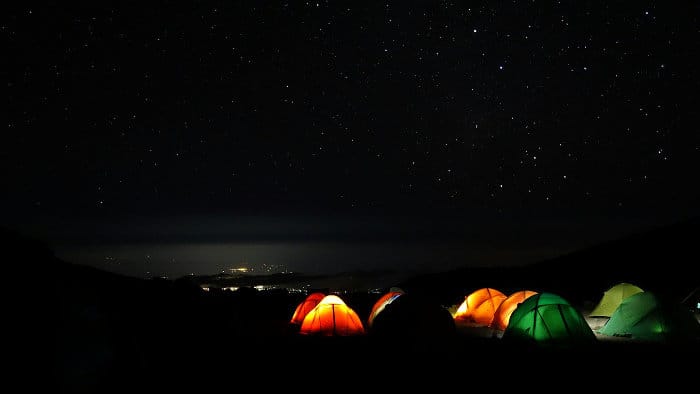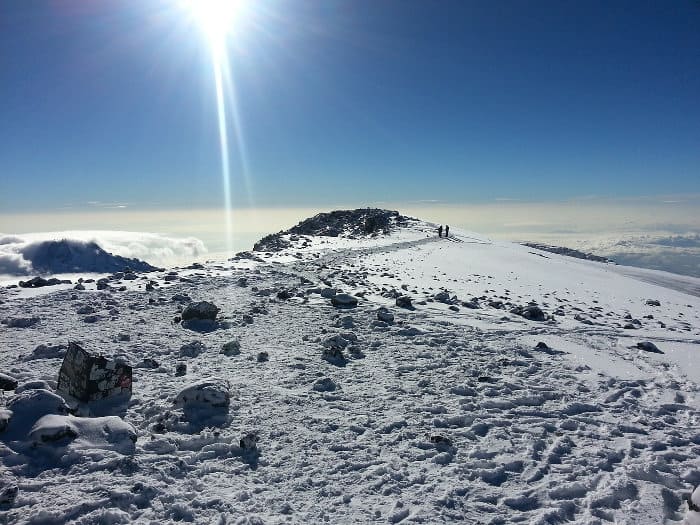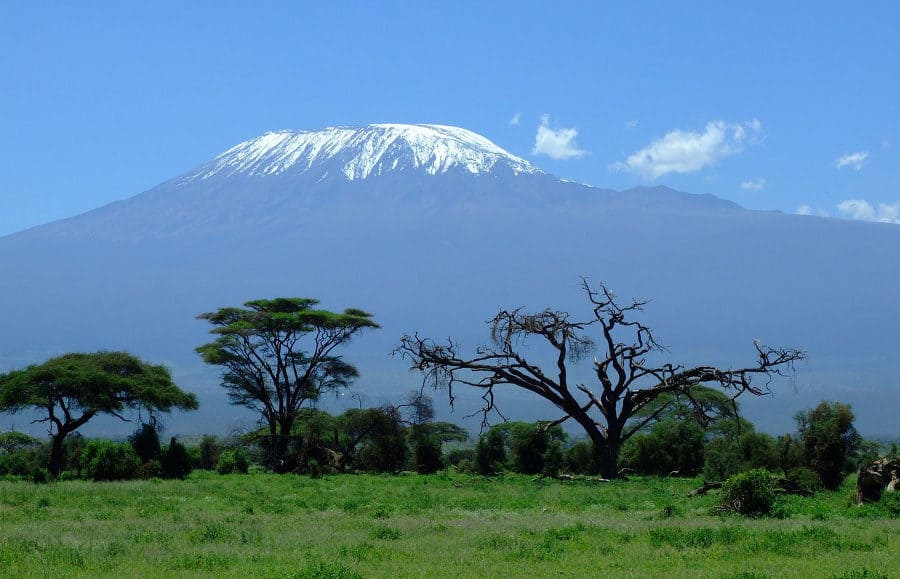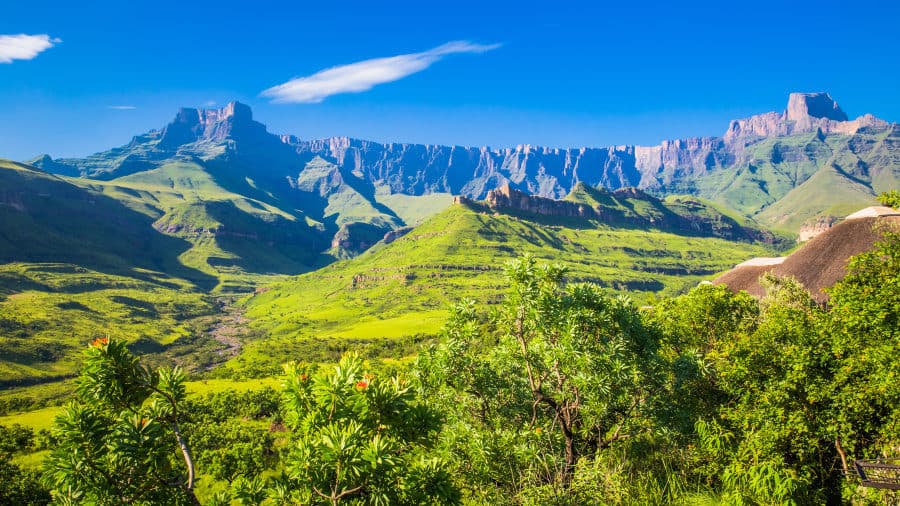Climbing Kilimanjaro can have a strange effect on climbers.
It’s not just the altitude.
Most people are so pumped with adrenaline upon arrival they’d start walking straight from airport departures. And probably not stop before reaching a magical 5895 metres above Africa.
Put on the hiking boots, tie the laces, and let’s do this!
But wait. Before charging onto Africa’s highest mountain like a migrating wildebeest you must choose which route to take. Kilimanjaro is one big mountain and each of the four main routes has its pros and cons.
This article guides you through the options. We’re not connected to a Tanzanian tour operator nor want to sell you a Kilimanjaro climb in any form.
We just know from experience that choosing a route is the most important first step for everyone climbing Kilimanjaro.
Climbing Kilimanjaro – The Basics

Where is Kilimanjaro?
Kilimanjaro is the highest peak in Africa and the world’s largest free-standing mountain, rising 5895 metres (19 340 feet) above dusty Tanzanian plains. It’s a dormant volcano with a summit that’s covered in snow all year around.
This magical mountain is located in northern Tanzania and the closest airport is Kilimanjaro International. Climbing the mountain can be combined with a Tanzania safari on the Northern Circuit, through Lake Manyara, Tarangire, Ngorongoro and the Serengeti.
Most trekkers stay in Moshi before and after the climb. This is a cute and easy to manage Tanzanian town with various small cafes and restaurants. Kilimanjaro looms high above Moshi and is just an hour by road to the trailheads.
How long does it take to climb Kilimanjaro?
Reaching the summit and coming back down will take you between five and nine days.
This depends on the route and how safe you wish to be.
Can I climb Kilimanjaro without a guide?

No. You cannot enter Mount Kilimanjaro National Park unless you have a guide and part of an organised tour. A tour can be for a single trekker or a group of 20 plus.
How much does it cost to climb Kilimanjaro?
Costs vary wildly between operators but expect to pay a minimum of USD 220 per day. This is for a very budget tour and mostly covers the extremely high park and camping permits.
All meals plus drinking water will be included in a tour, along with a guide, chef, and porters.
Budget tour operators have a tendency to not pay their staff. Instead, you are expected to pay tips to each guide and porter; these can run into many hundreds of dollars.
So a more realistic cost is USD 300 to 400 per day.
How fit do I need to be to climb Kilimanjaro?
Climbing Kilimanjaro should not be taken lightly. You will rise almost 5000 metres (16 400 feet) in altitude and it’s really tough on the body, even for very experienced trekkers.
You must be able to walk on steep mountain trails for six consecutive days. If walking up three flights of steps leave you out of breath then Kilimanjaro will be a daunting task.
Still, with training and good preparation Kilimanjaro is a realistic goal for most people.
Will I make it to the summit?

Only around 60% of those that set off make it to Kilimanjaro’s summit, a point known as Uhuru Peak. While this is partially due to your fitness level, success is mostly dictated by your reaction to high altitude.
Acute mountain sickness is incredibly common and causes fatalities each year on Kilimanjaro. Longer routes provide better altitude acclimatisation, dramatically improving your chances of reaching the summit.
Unfortunately, longer routes are more expensive as they spend more days on the mountain.
A Brief Overview of Kilimanjaro Climbing Routes

When climbing Kilimanjaro there are four main routes to choose from – Machame, Marangu, Rongai and Lemosho – Shira.
There is also Umbwe, a branch of the Machame route that is not recommended. Its steep rise in altitude is very dangerous and the trail is a real uphill slog.
All routes may have the same end goal; standing on the snow-capped summit at sunrise and gazing out onto the whole of Africa. But each offers a different experience and approaches the peak from an alternative angle.
There is no best route for climbing Kilimanjaro. Each is suited to different climbers and has its pros and cons. So before you tie the laces and set off on the adventure, think carefully about these four options.
Option 1 – The Marangu Route

Also known as the Coca Cola route due to its popularity, Marangu was traditionally the favourite Kilimanjaro trail.
It’s the shortest and quickest of all the routes, taking a direct path through the rainforest then up to the summit. It’s also the only way of climbing Kilimanjaro and sleeping in huts, rather than in tents that are pitched on the side of the mountain.
Sounds perfect? It is if you’re not an experienced climber and want a little more comfort during the climb, or if you must stick to a tight budget.
Marangu Profile
Day one ascends through a spectacular stretch of rainforest before you cross open moorland and stay in Horombo hut on day two. This is already at a giddy 3760 metres.
After hiking between the Mawenzi and Kibo peaks you rise to Kibo hut at 4730 metres. A breathless and breathtaking early morning ascent to the peak follows before you walk back down to Horombo hut.
With Marangu you walk up and down the same trail. This means the trail is very crowded and you only get views from one side of the mountain.
Marangu is possible in five days up and down but not recommended. With six days you’ll have an acclimatization day as well, doubling your chances of reaching the summit.
Altitude Acclimatization and Success Rate
A higher percentage of climbers develop altitude sickness on this trail than any other, although this is also because the route is favoured by most budget tour operators.
The five-day Marangu climb offers terrible and somewhat unsafe altitude acclimatisation. On this trek only a third of trekkers make it all the way to Uhuru Peak. An extra day costs more but pushes the success rate to around 60%.
Advantages of the Marangu Route
- Gradual ascents make this one of the easier routes up the mountain. There are no long traverses or overly challenging sections to catch out novice climbers.
- As it’s the shortest route it’s also the cheapest. By spending less time on the mountain there are lower National Park fees to pay.
- Marangu is the only route with sleeping huts. These offer shelter and warmth against the weather, along with bunk bed accommodation and a large communal dining hall.
- This route also offers the best rainforest trail section and excellent views of one side of the mountain.
Disadvantages of the Marangu Route
- The quick gains in altitude are challenging and sometimes dangerous, contributing to a lower percentage of people reaching the summit. Rather than climb high sleep low you climb high and sleep high, a no-no for experienced climbers.
- While the scenery is outstanding on Kilimanjaro, the Marangu route sticks to one side of the mountain. This severely limits the scenic variety.
- Marangu gets crowded with trains of trekkers and porters going up and down the same way. It can feel like a procession rather than a wilderness experience.
Option 2 – The Machame Route

Nicknamed the whisky route as it’s considered tougher than Coca Cola (Marangu), Machame is now the most popular way to climb Kilimanjaro. It’s a six or seven day hike that travels through each of the mountain’s unique ecosystems.
There are some steep climbs and scrambles to negotiate, as well as long days on the move. You ascend and descend on different trails, with each day of hiking providing a new experience.
Traversing peaks and passes, going up and down, then back up again, will give the legs a real workout. The muscles are going to be sore and Machame is the toughest option physically, usually preferred by those with some hiking experience.
There are no huts on this trail, so you’ll be camping the whole way, exposed to the elements while beautifully connected to mountain wilderness.
Machame Profile
You walk up through the rainforest, across moorlands, over an alpine desert, then ascend to the snowy peak. Starting from the west you circle the southern side of the mountain, then hike down to the southeast.
After rising quickly to 3000 metres on day one, this route eventually goes up and over Lava Tower on day three. After scrambling up Barranco Wall an early morning attack on the summit starts from Barafu Camp. The descent takes an alternative, more direct, route down the mountain.
Altitude Acclimatization and Success Rate

Spending longer on the mountain helps with altitude acclimatisation and Machame has a solid success rate. This stands at over 70% for the six-day climb and up to 90% for the seven-day climb.
Although you rise quickly at first, you spend three to four days in the 3000- to 4500-metre zone, following the hikers’ rule of climb high sleep low. This helps your body become accustomed to a lack of oxygen in the air.
Advantages of the Machame Route
- The scenery is spectacular. You experience each of the mountain’s individual ecosystems and there’s chance to see colobus monkeys on the descent.
- While the route is more challenging on the legs, good acclimatisation means that Machame has a higher percentage of people reaching the summit (compared to Marangu).
- By ascending and descending on different routes climbers get views from many different angles.
- Although challenging on the legs this is not a technical climb.
Disadvantages of the Machame Route
- Compared to Marangu the days are longer and the climbs steeper. As such it’s generally recommended for people with some hiking experience.
- There are no sleeping huts on this route. Each night is spent in tents that are set up by your porters.
- As this route spends longer on the mountain Machame is a little more expensive.
- Machame is now the most popular Kilimanjaro climbing route. The trail is long and isn’t too crowded outside the peak months of July to September, however the camping grounds are always packed.
Option 3 – The Rongai Route

Head to the northern side of the mountain and the Rongai route is a wild yet achievable climb. Accommodation is at quiet camps and there are both six and seven day versions of the trail.
You’re really in the wilderness, traversing monkey-dotted escarpments and crossing valleys that have only just started seeing human footprints.
Rongai receives just a fraction of the climbers when compared to Machame or Marangu, offering a solitude you would expect from the world’s highest free standing mountain.
Rongai Profile
Rongai is a gradual climb up the mountain’s northern side, with most of the views out towards Kenya and Amboseli National Park. There’s little scenic diversity over the first three days, but the final two days of ascent are the most spectacular on Kilimanjaro.
The ascent is gradual and there are no overly steep climbs to negotiate. Camps are neatly staggered and on the seven-day option you have a very relaxed and easy day before attacking the summit, contributing to a very high summit success rate.
After reaching Uhuru Peak you descend using the Marangu route. This may be crowded but does mean you explore both sides of the mountain.
Altitude Acclimatization and Success Rate
The acclimatisation isn’t perfect but much better than Marangu.
Climbing Kilimanjaro on the seven-day Rongai route has a summit success rate of over 80%. For experienced trekkers it’s above 90%.
Advantages of the Rongai Route
- The northern side of Kilimanjaro is drier, so this route is recommended if you’re climbing during or immediately after rainy season (March to May and November to December).
- This is a relatively easy route up the mountain and has excellent success rates.
- Rongai is the only route that allows you to experience both the north and south of the mountain.
Disadvantages of the Rongai Route
- Less operators offer tours on this route and it’s harder to join a group tour on dates that would suit.
- It’s more expensive than Marangu and Machame, due to the extra costs of reaching the northern side of Kilimanjaro, plus the lack of budget operators offering the climb.
- Rongai’s popularity is growing rapidly year on year and it may become crowded like Machame.
Option 4 – The Lemosho & Shira Routes

Step, step, step, slowly you ascend towards the crater rim, a white dappled peak luring you forward.
Climbing Kilimanjaro really ignites the imagination so it would be a shame to only spend five nights on the trail. At eight or nine days Lemosho is the longest route on offer, giving you maximum time lost in mountain beauty.
Expect spectacular scenery, few other hikers, and what climbing is all about; step, step, step, and slowly achieving your dream of standing on the roof of Africa.
Route Profile
Lemosho and Shira are variations of a route that approaches Kilimanjaro from the west and exclusively use camps for accommodation.
Shira can be done in only six days as you start by driving on a four-wheel drive track up the mountain.
This skips the rainforest zone and catapults you to over 3000 metres – easy for the legs you may think, but absolutely terrible for altitude acclimatisation. For this reason Shira is not recommended unless you have significant high-altitude trekking experience.
Lemosho is a much better choice, perhaps the best route for climbing Kilimanjaro. You trek up through remote rainforest, with plenty of wildlife around. The trail is almost empty for three days, before you cross into a lunar-like landscape and join the Machame route.
Although the Machame trail may be busy, the Lemosho camps are staggered differently to the main Machame campsites. This helps you avoid peak crowds, although not on the day before final ascent.
When descending Kilimanjaro you can choose from either the Machame or Marangu routes.
Altitude Acclimatization and Success Rate
Spending longer on the mountain ensures easy altitude acclimatisation and the greatest chance of successfully reaching the summit.
Over eight or nine days the Lemosho summit success rate is above 95%, the best of all routes for climbing Kilimanjaro.
Advantages of the Lemosho Route
- Trek along the least used trail and enjoy a real sense of untamed wilderness.
- Excellent altitude acclimatisation over eight or nine days maximises your chance of reaching the summit.
- This is a difficult climb over challenging terrain, however the hardest parts are at low altitude.
Disadvantages of the Lemosho Route
- Spending longer on the mountain means additional park fees and Lemosho is the most expensive route on the mountain.
- Only a handful of tour operators provide this option and it’s harder to join a scheduled a tour.
Still Unsure About Climbing Kilimanjaro – Just Do It

Rugged trails and steep ascents, long days and shivering into the sleeping bag each night: climbing Kilimanjaro doesn’t always seem like fun.
The final ascent is brutal, regardless of what route you take. Get woken at midnight and start trekking in the dark, climbing a steep volcanic trail at 5500 metres above sea level.
It’s silent and scary up here, your path illuminated by spotlight as hundreds of others make the same high-altitude expedition.
Everything hurts. Legs, mind, lungs, feet. When will it end? It’s on this final path that many must turn back because of altitude sickness. At this moment, so close to the summit, they would happily pay thousands more dollars to have one extra day and better altitude acclimatisation.

Walk onwards. Light flickers on the horizon. The summit comes into view. And as if by miracle your energy returns, meaning you practically run the final few steps.
Exhausted and elated you stand on the roof of Africa, looking out across endless savanna. The pain washes away. You’ve made it and there is no other feeling like it.
Was it worth it? Yes, yes, yes it was worth it! A single moment on the summit is worth all the pain and all the money.
So climbing Kilimanjaro? You won’t know how good it feels until you’re up there!




